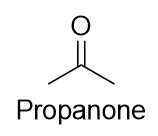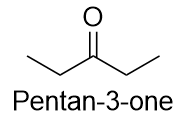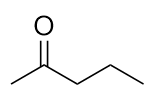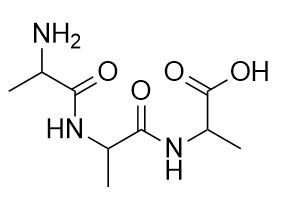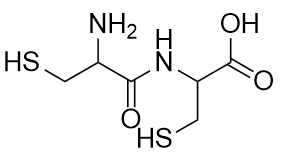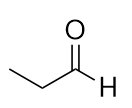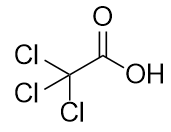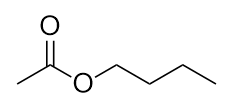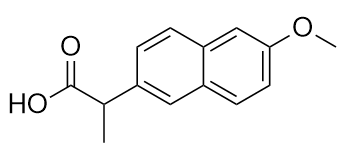Chapter 10. Organic Chemistry
10.6 Nomenclature of Aldehydes, Ketones, Carboxylic Acids, Esters, and Amides
Learning Objectives
By the end of this section, you will be able to:
- Describe the structure and properties of aldehydes, ketones, carboxylic acids, esters and amides
- Name and draw structures for aldehydes, ketones, carboxylic acids, esters and amides
Another class of organic molecules contains a carbon atom connected to an oxygen atom by a double bond, commonly called a carbonyl group. The carbonyl group can attach to two other substituents leading to several subfamilies, some of which are: aldehydes, ketones, carboxylic acids, esters and amides.
Naming of Aldehydes and Ketones
Both aldehydes and ketones contain a carbonyl group. In an aldehyde, the carbonyl group is bonded to at least one hydrogen atom. In a ketone, the carbonyl group is bonded to two carbon atoms. The names for aldehyde and ketone compounds are derived using similar nomenclature rules as for alkanes and alcohols, and include the class-identifying suffixes -al and -one, respectively:
Therefore when naming aldehydes following IUPAC, you follow these rules:
Rule 1. Identify the longest chain of carbons which contains the carbonyl group (PREFIX-ANE+AL). And when numbering the parent chain, the carbonyl group gets the lowest possible number, therefore it is always 1 and therefore is not included in the name.
Rule 2. Names and position of the substituents.
Methanal has a common name with which you may be familiar: formaldehyde.
When naming ketones following IUPAC, you follow these rules:
Rule 1. Identify the longest chain of carbons which contains the carbonyl group (PREFIX-#-ANE+ONE). And when numbering the parent chain, the carbonyl group gets the lowest possible number. In the smaller ketones (propanone and butanone), the locant number is not used because there is no alternative placement in these smaller ketones.
Rule 2. Names and position of the substituents.
The common name for propanone is acetone. There is a non-IUPAC way to name ketones that is commonly used as well: name the alkyl groups that are attached to the carbonyl group and add the word ketone to the name. So propanone can also be called dimethyl ketone, while butan-2-one is called methyl ethyl ketone.
In condensed structure, an aldehyde group is represented as –CHO; a ketone is represented as –C(O)– or –CO–.
Example 1
Draw the structures of: a) pentan-2-one; b) hexan-2-one; c) butane
Solution
a) This molecule has five C atoms in a chain, with the carbonyl group on the second C atom. Its structure is:
b) This molecule has six C atoms in a chain, with the carbonyl group on the second C atom. Its structure is:
c) This molecule has four C atoms in a chain, with the carbonyl group on the first C atom since it is an aldehyde (ends with -al). Its structure is:

Test Yourself
Give the condensed structure of the following amines:
a) propanone b) propanal c) heptan-3-one d) octanal
Answer
a) CH3COCH3 b) CH3CH2CHO
c) CH3CH2CH2CH2COCH2CH3 or CH3(CH2)3COCH2CH3
d) CH3CH2CH2CH2CH2CH2CH2CHO or CH3(CH2)6CHO
Naming Carboxylic Acids and Esters
Both carboxylic acids and esters contain a carbonyl group with a second oxygen atom bonded to the carbon atom in the carbonyl group by a single bond. In a carboxylic acid, the second oxygen atom also bonds to a hydrogen atom. In an ester, the second oxygen atom bonds to another carbon atom. The names for carboxylic acids and esters include prefixes that denote the lengths of the carbon chains in the molecules.
The names for carboxylic acid and ester compounds are derived using similar nomenclature rules as seen previously with aldehydes, and include the class-identifying suffixes -oic acid and -oate, respectively:
Therefore when naming carboxylic acids following IUPAC, you follow these rules:
Rule 1. Identify the longest chain of carbons which contains the carbonyl group (PREFIX-ANE+OIC ACID). And when numbering the parent chain, the carbonyl group gets the lowest possible number, therefore it is always 1 and therefore is not included in the name.
Rule 2. Names and position of the substituents.
When naming esters following IUPAC, you follow these rules:
Rule 1. Identify the longest chain of carbons which contains the carbonyl group (PREFIX-ANE+OATE). And when numbering the parent chain, the carbonyl group gets the lowest possible number, therefore it is always 1 and therefore is not included in the name. AND then name the other carbon chain (PREFIX+YL).
Rule 2. Names and position of the substituents.
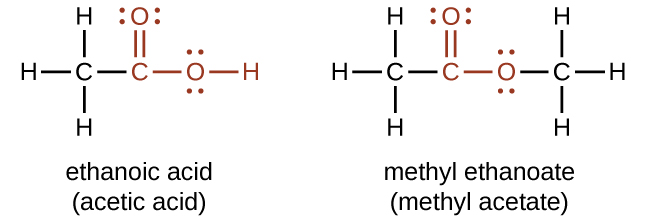
The functional groups for an acid and for an ester are shown in red in these formulas. In brackets you have the common names for ethanoic acid and methyl ethanoate.
The hydrogen atom in the functional group of a carboxylic acid will react with a base to form an ionic salt:

Carboxylic acids are weak acids (see the chapter on acids and bases), meaning they are not 100% ionized in water. Generally only about 1% of the molecules of a carboxylic acid dissolved in water are ionized at any given time. The remaining molecules are undissociated in solution.
In condensed structure, the carboxylic acid group is represented as –COOH; an ester is represented as –COO– .
Example 2
Draw the structures of: a) 3-methylpentanoic acid; b) ethyl ethanoate; c) propyl 2-chlorobutanoate
Solution
a) Its structure is:
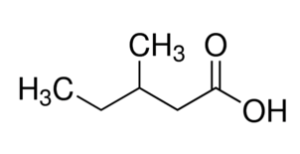
b)Its structure is:
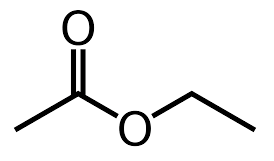
c) Its structure is:
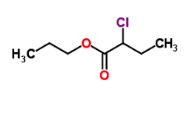
Test Yourself
Name the following compounds:
a) CH3CH2COOH b) CH3CH2CH2CH2COOCH2CH3 c) BrCH2(CH2)2COCH3 d) (CH3)2CH(CH2)6COOH
Answer
a) propanoic acid b) ethyl pentanoate c) methyl 4-bromobutanoate d) 9-methylnonanoic acid
Example 3
Complete the chemical reaction.
Solution
The OH– ion removes the H atom that is part of the carboxyl group:
The carboxylate ion, which has the condensed structural formula CH3CO2−, is the ethanoate ion, but it is commonly called the acetate ion.
Test Yourself
Complete the chemical reaction.
Answer
The ion is the methanoate ion, which is commonly called the formate ion.
Naming Simple Amides
Amides are molecules that contain nitrogen atoms connected to the carbon atom of a carbonyl group. The names for amide compounds are derived using similar nomenclature rules as seen previously with aldehydes and carboxylic acids, and include the class-identifying suffixes -amide:
Therefore when naming amides following IUPAC, you follow these rules:
Rule 1. Identify the longest chain of carbons which contains the carbonyl group (PREFIX-ANE+AMIDE). And when numbering the parent chain, the carbonyl group gets the lowest possible number, therefore it is always 1 and therefore is not included in the name.
Rule 2. Names and position of the substituents.
In condensed structure, the amide group is represented as –CONH2 or –CONHR or –CONR2.
Example 4
Give the condensed structures of: a) decanamide; b) hexanamide; c) 2-chloroethanamide
Solution
a) Its condensed structure is: CH3(CH2)8CONH2
b) Its condensed structure is: CH3(CH2)4CONH2
c) Its condensed structure is: ClCH2CONH2
Test Yourself
Name the following compounds:
a) CH3(CH2)2CONH2 b) BrCH2(CH2)3CONH2 d) (CH3CH2)2CH(CH2)5CONH2
Answer
a) butanamide b) 5-bromopentanamide c) 7-ethylnonanamide
Key Concepts and Summary
Functional groups related to the carbonyl group include the –CHO group of an aldehyde, the –CO– group of a ketone, the –CO2H group of a carboxylic acid, the –CO2R group of an ester and the –CONH2 group of an amide.
The systematic methods of naming these carbonyl containing functional groups follow a similar procedure and the names have three main parts:
1) specifying the information about the substituents,
2) specifying the information about the parent chain, and
3) the ending which specifies what functional group is present in the structure being named.
Aldehydes: #-substituents–PREFIX–ANE+AL
Ketones: #-substituents–PREFIX–ANE+ONE
Carboxylic Acids: #-substituents–PREFIX–ANE+OIC ACID
Esters: ALKYL #-substituents–PREFIX–ANE+OATE
Amides: #-substituents–PREFIX–ANE+AMIDE
Exercises
1. Write a condensed structural formula of the following compounds.
a) 2-propanol
b) acetone
c) dimethyl ether
d) acetic acid
e) 3-methyl-1-hexene
2. A peptide is a short chain of amino acids connected by amide bonds. How many amide bonds are present in this peptide?
4. Name a similarity between the functional groups found in aldehydes and ketones. Can you name a difference between them?
5. Name each molecule.
10. The drug known as aspirin is shown here. Identify the functional group(s) in this molecule.
11. The drug known as naproxen sodium is the sodium salt of the molecule shown here. Identify the functional group(s) in this molecule.
4. They both have a carbonyl group, but an aldehyde has the carbonyl group at the end of a carbon chain, and a ketone’s carbonyl carbon is surrounded by two other carbons.
5. a) proposal b) butanone
6. a) 3-chloro-3-methylbutanal b) heptan-4-one
7. a) 3-methylbutanoic acid b) ethyl propionate
8. a) 2,2,2-trichlroethanoic acid b) butyl ethanoate
9. ethyl propyl ether
10. carboxylic acid, arene and ester
11. carboxylic acid, arene and ether
Glossary
aldehyde: organic compound containing a carbonyl group bonded to two hydrogen atoms or a hydrogen atom and a carbon substituent
carbonyl group: carbon atom double bonded to an oxygen atom
carboxylic acid: organic compound containing a carbonyl group with an attached hydroxyl group
ester: organic compound containing a carbonyl group with an attached oxygen atom that is bonded to a carbon substituent
ketone: organic compound containing a carbonyl group with two carbon substituents attached to it


